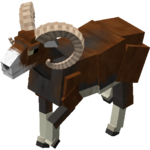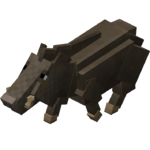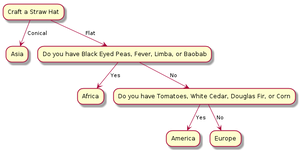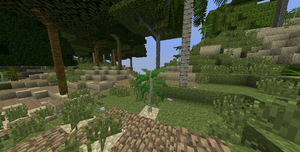Difference between revisions of "Differences From TFC"
| Line 145: | Line 145: | ||
* Mushrooms can be crafted into food with a knife. Red Mushrooms must be cooked or they will poison the player when eaten. | * Mushrooms can be crafted into food with a knife. Red Mushrooms must be cooked or they will poison the player when eaten. | ||
* Vinegar is no longer made from putting fruit in alcohol; instead, alcohol is left unsealed until it turns into vinegar. | * Vinegar is no longer made from putting fruit in alcohol; instead, alcohol is left unsealed until it turns into vinegar. | ||
| + | |||
| + | == Alcohol == | ||
| + | {{main|Alcohol}} | ||
| + | Alcohol production in TFC+ is quite different and more detailed than it was in classic TFC. Sealing food in a barrel will create tier 1 alcohol, beer can be made only by malting grains, and tier 2 alcohol has to be distilled to be created. | ||
== Ores and Minerals == | == Ores and Minerals == | ||
Revision as of 23:26, 8 February 2020
Welcome to Terrafirmacraft+! Terrafirmacraft+ makes many significant improvements and changes from Terrafirmacraft. This page is for existing players of Terrafirmacraft that are migrating to Terrafirmacraft+, and describes the notable changes between the two. For new players, look at the Stone-Age Guide.
This article assumes you have installed Terrafirmacraft+; if not, look at the Installation page.
Contents
World Generation
- Main article: Land
World generation has been given an complete overhaul in Terrafirmacraft+. Rivers are much larger, and generate clay on their riverbeds. There are no longer any abrupt climate changes, and climate smoothly changes throughout the world. Sunrise and sunset is now based on latitude, which means days will get shorter in winter and longer in summer for temperate areas. Towards the poles, the sun will not rise in winter, and will be above the horizon for all of summer, causing polar night and midnight sun.
Regions
- Main article: Regions
In the original Terrafirmacraft, the world was generated based on three variables: Rainfall, EVT, and Temperature. Terrafirmacraft+ introduces a fourth variable, Regions, which, along with the original three variables now decides what trees, crops, and animals generate in an area. The regions, based on the continents of Earth, are: The Americas, Asia, Europe, and Africa. Mountain ranges will generate on the borders of two regions, serving as a marker between them.
Different regions also cause several changes to happen. In Asia, for instance, crafting a Straw Hat will make it look conical. In other regions, crafted Straw Hats will appear flat. This, combined with the knowledge of what trees, crops, and animals generate, can be used to guess what region a player is in. The only way to precisely tell what region a player is in is to use the Compass, which will tell the player the region they are in in the top left hand corner of the screen.
Trees
- Main article: Trees
Unlike the original Terrafirmacraft, more than three types of trees can generate in an area. Any tree that can generate in a region can generate, as long as the rainfall, EVT, and temperature are suitable.
Most trees now generate with thin trunks and with branches. They will drop thin logs, which cannot be built with. However, four thin logs can be crafted into stacked logs, which can be used to build. Occasionally, a Large tree will generate, which is significantly larger than the other trees. They will drop large logs, which are like the old Terrafirmacraft logs, and can be chopped with an ax to create Chopped Logs, which are the same as normal small logs.
Fruit trees are generated differently from Terrafirmacraft. They generate like every other tree, with thin trunks and branches. Unlike Terrafirmacraft+, one cannot obtain saplings by breaking branches. Instead, at least 40oz of undecayed fruit must be placed in the center slot of a Large Ceramic Vessel, and surrounded with 2 dirt in every other slot. Once the fruit decays completely, it will be replaced with a fruit tree sapling.
Under trees, leaf litter will generate. Leaf litter can be broken to obtain mushrooms, feathers, or sticks. Undergrowth will also generate in forests, and can be broken with an ax to obtain sticks.
Body Temperature
- Main article: Body Temperature
Body Temperature is a new mechanic in Terrafirmacraft+. It is shown by a thermometer on the bottom right side of the screen. The green area of the thermometer shows the player's comfort range. The player's body temperature is affected by the season, their local climate, and certain blocks. If the player is too hot, or too cold, they will suffer negative effects such as Slowness and Mining Fatigue. They will also not be able to sleep in Straw Beds. Being too hot, or too cold, will also cause the player to lose hunger and thirst faster, as their bodies will "sweat" to keep cool, or burn calories to warm themselves up.
Wood
- Main article: Wood
Terrafirmacraft adds several new recipes to and changes wooden items significantly. As mentioned above, logs now come in two sizes - regular and large. Large logs can be hewed with an axe to create Chopped Logs, which are functionally identical to regular logs. Four regular logs can be stacked together in the crafting grid to create Stacked Logs, which are functionally identical to large logs.
Logs can now be made into a pole with a knife. The pole is used in the crafting of several tools, including the Javelin, the Fishing Rod, the Bow, the Staff, and the Wooden Spear. The Staff is a new item that allows you to walk faster on foot when held, while the Wooden Spear is an early-game alternative to the Javelin which is less expensive but also less effective.
Four regular logs can be made into one stacked log for building. |
A large log can be cut with an ax to make Chopped Logs, which are functionally identical to regular logs. |
The pole is a new crafting item used for items that need a longer handle. | ||||||||||||||||||||||||||||||||||||
Poles can be crafted into two sticks. |
The wooden staff is a new item that allows you to walk faster on foot, and paddle in a boat, when held. |
The wooden spear is an early-game alternative to the javelin which is less expensive but also less effective. | ||||||||||||||||||||||||||||||||||||
The bow recipe is changed to use poles. |
The bow drill is made from a bow and a firestarter. It is an upgraded version of the firestarter with higher durability and efficiency. |
Straw and Grass Weaving
- Main article: Straw
Straw is much more important in Terrafirmacraft+ as opposed to vanilla Terrafirmacraft. Straw can now be woven by holding more than 5 pieces in your hand and ![]() Right Clicking. Many early-game clothing pieces, and the new Basket, which is an early game non-portable storage solution (unlike the Large Vessel, it will drop its' items if it is broken), are made from Straw.
Right Clicking. Many early-game clothing pieces, and the new Basket, which is an early game non-portable storage solution (unlike the Large Vessel, it will drop its' items if it is broken), are made from Straw.
Straw and hide beds can now be slept in. There are no disadvantages for sleeping in a straw and hide bed right now.
Pottery
- Main article: Pottery
Three new ceramic items are added: the Blowpipe, the Sheet Mold, and the Ceramic Bucket. The Blowpipe and Sheet Mold can be used for Glassworking to create Glass Bottles and Glass Panes from Molten Glass. The Sheet Mold can also make metal sheets from castable metals. The Ceramic Bucket can contain water, and is used to wet Dirt and Straw to create Mud.
The Blowpipe can be used to make glass bottles. Place the Blowpipe in a vessel of molten glass, and let it fill. |
The Sheet Mold can be used to make glass and metal sheets. |
The Clay Bucket is used to carry water. It is an early game alternative to the wooden bucket, and allows for the crafting of Mud. |
Weapons
Weapons now have attack speed and range. For example, the Knife has a short range while the Javelin has a long range. The range is stated in the item's tool tip. The crosshair will show a red circle while the weapon is on cooldown.
Mud
- Main article: Mud
Mud is a construction material that can be can be formed into Mud Bricks and dried in the sun to make Mudbrick blocks. Mud can also be applied to Wattle walls to make Wattle and Daub blocks.
Mud is crafted by dropping and equal number of Dirt and Straw on the ground, and then pouring water from a Wooden or Ceramic Bucket onto the items. 1 straw and 1 dirt will create 2 mud. A bucket of water can turn 32 dirt and 32 straw into 64 mud.
 Mudbrick
Mudbrick
Craft Mud Bricks by placing Mud in a crafting slot.
| |
| ||
| | |||
Mud Bricks must be dried by shift and right clicking it onto the ground and leaving them exposed to the sun during the day (6 AM - 6 PM). The mud brick will change to a lighter color once it is dried and can be picked up by left-clicking the block. The dried mud bricks can now be used to craft Mudbrick blocks.
| |
|
| |
| | |||
| |
| ||
Mudbrick blocks will turn back into dirt if they get wet from the rain. They can be protected by a Roof, such as a Thatch Roof.
 Wattle and Daub
Wattle and Daub
Mud can be daubed over a Wattle by holding it and right-clicking. Wattle and Daub does not need to dry and does not dissolve in the rain.
Crops and Food
- Main article: Agriculture
Terrafirmacraft+ adds several new crops: grapes, black-eyed peas, melons, bananas, papayas, dates, woad, weld, madder, cotton, agave, and flax.
Among these crops, several behave differently from the crops of the original Terrafirmacraft:
- Grapes are planted on ladders, and take a year to grow. They can be harvested without being broken.
- Woad, weld, and madder can be made into liquid dye (blue, yellow, and red, respectively) to dye clothing.
- Cotton and flax can be made into cloth for the creation of clothing.
- Agave is an alternative to Jute.
Several foods also behave differently:
- Pumpkins can be crafted into food with a knife. This will result in Pumpkin Shells and Pumpkin. The shells can be crafted into Jack-O-Lanterns.
- Mushrooms can be crafted into food with a knife. Red Mushrooms must be cooked or they will poison the player when eaten.
- Vinegar is no longer made from putting fruit in alcohol; instead, alcohol is left unsealed until it turns into vinegar.
Alcohol
- Main article: Alcohol
Alcohol production in TFC+ is quite different and more detailed than it was in classic TFC. Sealing food in a barrel will create tier 1 alcohol, beer can be made only by malting grains, and tier 2 alcohol has to be distilled to be created.
Ores and Minerals
- Main article: Ores & Minerals
| |
|
| Chalcocite | Chalcopyrite |
Two new copper ores are added: Chalcocite, and Chalcopyrite. Chalcocite is a dark bluish color, and spawns in Sedimentary rocks. Chalcopyrite is golden in color, and spawns in Igneous Intrusive rocks. This makes all of the stone types generate copper ores.
Gypsum
Gypsum is no longer useless, as it can now be crafted into Plaster of Paris. Plaster of Paris can be applied with a Trowel to fireproof Wooden Planks, make Mud Bricks waterproof, and apply a white texture to Stone Blocks and Wattle and Daub.
| |
| ||
| | |||
| |
|||
| |

|
|||||||||
| |
|||||||||
| |

|

|
|||||||
| |
|
||||||||
Flux
- Main article: Flux
Terrafirmacraft+ changes the production of Flux. It is now made from Lime, a new item, that can also be used to make Limewater, and is an ingredient in the new Glass recipe. Sands, gravels, or rocks from the four flux-stones, Dolomite, Marble, Limestone, or Chalk, can be heated to produce Lime. Seashells can also be heated to produce Lime. This makes Flux slightly less annoying to obtain.
| |
Can be heated in: | ||||
| |
|
|
|
||
| |
Temp: Bright Red⋆⋆⋆⋆ | ||||
| |
| ||
| | |||
Animals
- Main article: Mobs

|

|
| Mouflon | Boar |
Animals, at the time of writing, are in the process of being updated. Currently, the updated mobs are the Mouflon (previously the Sheep), and the Boar (previously the Pig). All animals will eventually be updated, and new exotic ones added.
In Terrafirmacraft+, animals spawn as their wild version, and must be tamed and bred for at least two generations before they turn into their domestic versions. They will lie down and sleep at night, seek shelter in the rain, and forage through leaf litter for food. They will also hit back when players harm them, and in the case of the Boar, will chase and potentially kill the player. The amount of damage they deal is dependent on their body size.
Mouflon will only generate wool when it is winter, but Sheep, their domestic version, will generate wool year-round.
Cloth, Clothing and Sewing
To manage Body Temperature, clothing must be made. Early game clothing can be made from Straw, but better and more effective clothing must be made from cloth. Terrafirmacraft+ adds a few new sources of cloth. Along with wool, cloth can now be made from cotton, flax, silk, jute, and agave. Cotton, silk and flax become cotton cloth, silk cloth and linen cloth respectively. Jute and agave become burlap cloth, which cannot be made into clothing, but can be made into Burlap Sacks, which are a new storage and preservation for non-grain food.
In order to create clothing, pieces of cloth must be cut into clothing pieces, which must then be sewn with a Bone Needle in order to create the final clothing piece. Bone Needles are obtained by continuously hitting a Stone Block with a Bone. Several Bones will need to be broken before a Bone Needle will be produced. The Bone Needles must be threaded with sinew, or any fiber, before it can be used to sew. To open the sewing interface, ![]() Right Click with an item that can be sewn. Then, load the correct amount of pieces into the slots. For example, a Shirt requires two shirt bodies and two shirt sleeves. An image of the final item will be shown, with red lines indicating where it must be sewn. The Bone Needle must be used to trace the red lines, within an acceptable accuracy. Any incorrect lines will show up in red, and must be cut away by using the tip of a knife by
Right Click with an item that can be sewn. Then, load the correct amount of pieces into the slots. For example, a Shirt requires two shirt bodies and two shirt sleeves. An image of the final item will be shown, with red lines indicating where it must be sewn. The Bone Needle must be used to trace the red lines, within an acceptable accuracy. Any incorrect lines will show up in red, and must be cut away by using the tip of a knife by ![]() Right Clicking. Bone Needles are also used in the crafting of the Fishing Rod.
Right Clicking. Bone Needles are also used in the crafting of the Fishing Rod.
Many items are added that are crafted by sewing.
- Bags can be crafted from raw hide and leather. One small raw hide or one leather can be crafted into two Bag Pieces, which can be sewn together to make a Raw Hide or Leather Bag. Bags take damage - raw Hide bags last only a month, while the Leather bags can last a year.
- Burlap Sacks, as mentioned, are a preservation and storage solution for non-grain food. One Burlap Cloth becomes two Burlap Sack Pieces, which then can be sewn into one Burlap Sack.
- Clothing can manage body temperature, depending on the piece and material. Silk Cloth and Straw are good for hot climates, while Wool and Cotton cloth are good for cold climates. Linen is good for either hot or cold climates, depending on the piece you craft.
The table below shows the protection various materials and pieces provide.
| Clothing Temperature Protection [Edit] | |||||||
|---|---|---|---|---|---|---|---|
| |
|
|
|
|
|
| |
| |
= | + | + | − + | − ++ | + | N/A |
| |
= | + | + | − ++ | −− +++ | = | N/A |
| |
+ | + | + + | ++ | ++ + | + + | N/A |
| |
+ | + | + | −− +++ | −− ++++ | + | N/A |
| |
N/A | −− +++ | N/A | −− ++++ | N/A | − ++ 1 | ++ |
| |
N/A | N/A | N/A | −−− +++++ | N/A | ++ 1 | − ++ |
| |
N/A | N/A | N/A | −− +++ | N/A | + | + |
| |
− + | + | + | −− ++ | N/A | + | = |
| Legend | |||||||
| − + Heat Resistance penalty/bonus | − + Cold Resistance penalty/bonus | = Neutral | |||||
- There are two varieties of fur hat: the generic fur hat that is sewn, and the animal's head hat, which is cut from the fur using a knife. They are identical in protection.
Clothing made from Cloth can be dyed. Woad, weld, ash, ink sacs, and madder can be made into liquid dye (blue, yellow, white, black, and red, respectively) to dye clothing, by placing them in a barrel of tannin. Clothing gradually becomes deeper colored every hour it is placed in the dye.
Clothing will get wet if a player is submerged in water. To dry clothing, the clothes must be placed in a firepit. Wet clothing does not provide as much temperature protection.
Roofing
- Main article: Roof
Several roofing solutions are added. Roofing can be used for decoration, and also provides heat or cold protection. Thatch Roofs can be made from Straw Blocks and a stick, and provides a moderate cold protection bonus to players below it. Ceramic Tile Roofs are made from Ceramic Tiles, which can be crafted by wrapping clay around a Log, and then Pit Kilned. They provide heat and cold protection. Slate Roofs are made from Slate Shingles, which can be crafted by crafting a Chisel with Slate Bricks. They provide enormous amounts of cold protection, and a moderate amount of heat protection. All Roofs will raise the texture of the solid blocks below them to create a seamless texture.
Ceramic Tile Roofs and Slate Roofs can be crafted into peaks, which can be used to connect two sides of a roof.
| Thatch Roof | ||||||||||||
|---|---|---|---|---|---|---|---|---|---|---|---|---|
|
| Clay Tile | Ceramic Tile Roof | Ceramic Tile Roof Peak | |||||||||||||||||||||||||||||||||||||||||
|---|---|---|---|---|---|---|---|---|---|---|---|---|---|---|---|---|---|---|---|---|---|---|---|---|---|---|---|---|---|---|---|---|---|---|---|---|---|---|---|---|---|---|---|
|
|
|
| Slate Shingle | Slate Roof | |||||||||||||||||||||||||||||
|---|---|---|---|---|---|---|---|---|---|---|---|---|---|---|---|---|---|---|---|---|---|---|---|---|---|---|---|---|---|---|
|
|
Glassworking
- Main article: Glassworking
Glassworking is overhauled to be more realistic. Molten Glass is made from smelting a 1:1:1 ratio Silica Sand, Lime, and Soda Ash, or a 1:1:2 ratio with Ash replacing Soda Ash, in a Ceramic Vessel. The resulting glass can be poured into a Sheet Mold to make Glass Sheets, or into a Blowpipe to make Glass Bottles. Once the molten glass is in the blowpipe, one can simply ![]() Right Click to remove the glass bottle. If more than 1000 units of Molten Glass is left to solidify, it will turn into Glass Blocks.
Right Click to remove the glass bottle. If more than 1000 units of Molten Glass is left to solidify, it will turn into Glass Blocks.
Kiln
- Main article: Kiln
A new, larger, Kiln is added in order to kiln many items at once. However, it is more expensive to make and operate, and takes more time to process the items.
Musical Instruments
Several functioning Musical Instruments are added. These include the Bone Flute, the Bugle, the Conch, the Lyre, the Horn and the Drums.
Future Updates
- Main article: Planned Features
Future updates will include a smithing, cooking, and carpentry overhaul, and it is planned to re-add the Nether, for a complete end-game.
| Construction | Barrels • Blueprints • Bricks • Firepit • Plank Blocks • Protection Meter • Quern • Smooth Stone • Straw & Hide Bed • Support Beams • Straw Block • Glassworking • Plaster of Paris • Mud • Teepee • Kiln • Smoke Rack • Roads • Roof • Rope Ladder • Containers |
|---|---|
| Environment | Altitude • The Player • Wound • Calendar • Cobblestone • Logs • Mobs • Saplings • Seasons • Stone • Seashell • Temperature • Body Temperature • Clothes • Trees • Biome • Regions |
| Food | Agriculture • Animal Husbandry • Berries • Fruit Trees • Alcohol • Beekeeping • Fishing • Shellfish |
| Materials | Charcoal • Coal • Double Ingots • Double Sheets • Flux • Gems • Gunpowder • Hides • Fur • Wool • Cloth • Ingots • Leather • Lumber • Minerals • Pottery • Redstone/Powders • Sheets • Sticks • Straw • Unshaped Metal |
| Metalworking | Alloys • Anvils • Armor • Bellows • Blast Furnace • Bloomery • Tool Molds • Crucible • Forge • Gold Pan • Metals • Ores • Sluice • Mechanisms |
| Tools & Weapons | Arrows • Axe • Buckets • Chisel • Firestarter • Flint & Steel • Hammer • Hoe • Javelin • Knife • Mace • Pickaxe • Prospector's Pick • Saw • Shovel • Sword • Sling • Scythe • Shears • Spindle • Trowel • Wooden Staff • Musical Instruments |
| Modpacks | Telomerase |

